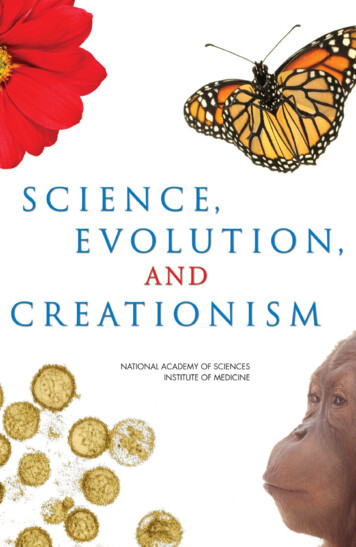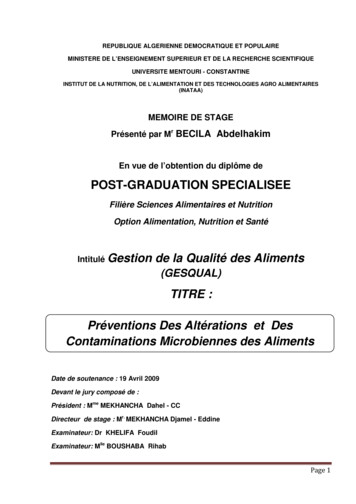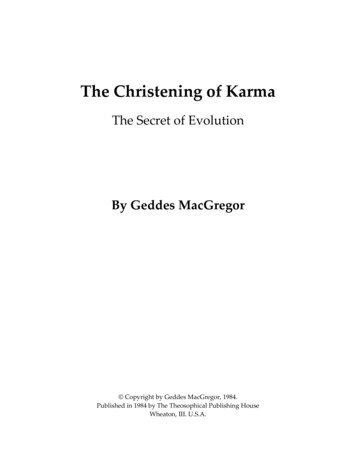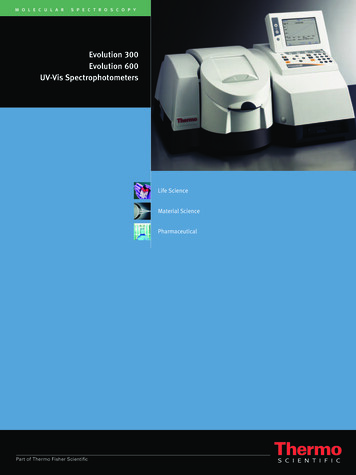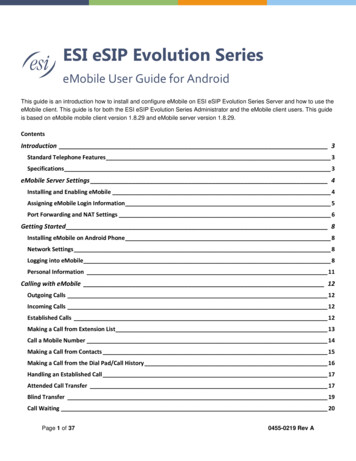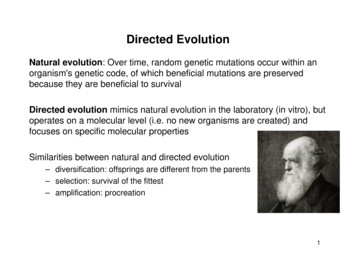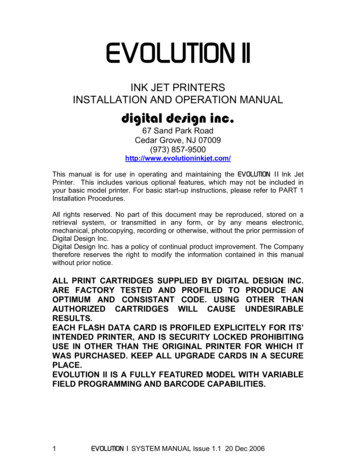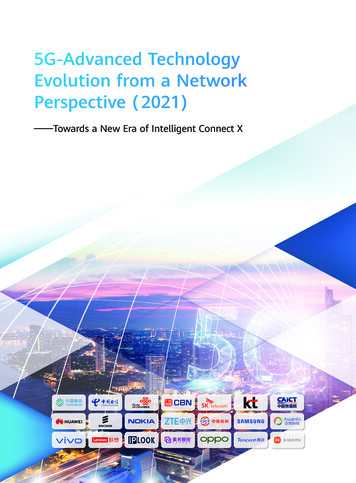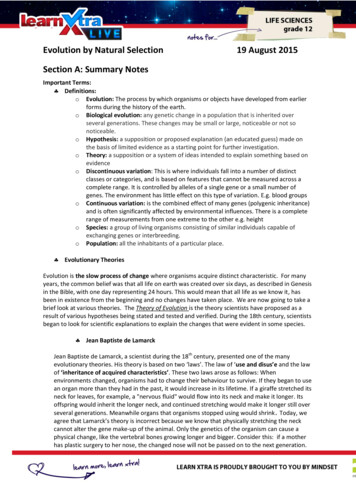
Transcription
ISSN:2250-1142 (Online), ISSN 2349-302X (Print)International Journal of Digital Library ServicesVol. 6, April - June 2016, Issue - 2www.ijodls.inEVOLUTION OF THE WORLD WIDE WEB: FROMWEB 1.0 TO 6.0Ku. Chhaya A. KhanzodeLibrarianG. H. Raisoni College of Engineering & Management, Amravati (India)Email: chhayakhanzode@gmail.comDr. Ravindra D. SarodeAssistant ProefssorDepartment of Library & Information ScienceSant Gadge Baba Amravati University, Amravati (India)Email: smilerdx@rediffmail.comAbstractThe fast lane toward the development of web is coined to be as an outrightphenomenon in the today ‗s society with incorporated use of moderninnovative technology and redefining the way of organizing , communicatingand collaborating with individual which in terms lead us to mixture ofspectacular successes and failures. The purpose of this paper is to understandand conceptualize the evolution of web from the scratch to the upcoming trendsin the field of Web Technology.Keywords: Web 1.0, Web 2.0, Web 3.0, Web 4.0, Web 5.0, Web 6.0, Semantic Web1. Introduction:In today‘s era web technology can be easily defined by the user indifferent descriptiveway. But matter in fact many user are quite unknown to the information that from wherethe WWW was coined first. As this paper state the evolution of web so it is important toinitiate the story from the beginning where it was stated first.Largest transformable-information constructs i.e. Web introduce by Tim Burners-Lee in1989 at first [9] [10]. Immense progress had been made about web and relatedtechnologies. Web 1.0 referred as a web of information or percipience, Web 2.0 as web ofverbalization, web 3.0 as web of affiliation and web 4.0 as a web of integration and Web5.0 as web of Decentralized smart communicator. This paper would attempt to build auser centric view of the composition of features generation of web technology. In sum,the paper presents a holistic view of the World Wide Web.IJODLS Geetanjali Research Publication1
ISSN:2250-1142 (Online), ISSN 2349-302X (Print)International Journal of Digital Library ServicesVol. 6, April - June 2016, Issue - 2www.ijodls.in2. World Wide Web:The World Wide Web is a system of interlinked hypertext document accessed via theinternet [21]. With a web browser, one can view web pages that may contain text, image,videos, and other multimedia and navigate between them via hyperlinks. On March 12,1989, Tim Berners-Lee, a British computer scientist and former CERN employee wrote aproposal for what would eventually become the World Wide Web [1]. The 1989 proposalwas meant for a more effective CERN communication system but Berners-Lee eventuallyrealized the concept could be implemented throughout the world. Berners-Lee andBelgian computer scientist Robert Cailliau proposed in 1990 to use hypertext ― to link andaccess information of various kind as a web of nodes in which the user can browse at will―[22]. In these ways the first web service was designed and tested and latterly confined asWord Wide Web.3. Web 1.0:Web 1.0 was first implementation of the web and lasted from 1989 to 2005.It was defineas web of information connection. According to the innovator of World Wide Web, TimBerners-Lee considers the web as ―read-only‖ Web [1]. It provides very little interactionwhere consumer can exchange the information together but it was not possible to interactwith the website. The role of the web was very passive in nature.Web 1.0 was referred as the first generation of World Wide Web which was basicallydefined as ―It is an information space in which the items of interest referred to asresources are identified by global identifier called as Uniform ResourcesIdentifiers(URLs)‘‘First generation web was era static pages and content delivery purpose only. In otherworld, the early web allowed us to search for information and read it. There was verylittle in the way of user interaction or content contribution.3.1 Characteristics Web 1.0:Web 1.0 Technologies includes core web protocols, HTML, HTTP, and URI. The majorcharacteristics of web 1.0 are as follow: They have read only content.Establish an online presence and make their information available to anyone atany time.It includes static web pages and use basic Hypertext Mark-Up Language.3.2 Limitation Web 1.0:The major limitations of web 1.0 are as follow: The Web 1.0 pages can only be understood by humans (web readers) they do nothave machine compatible content.IJODLS Geetanjali Research Publication2
International Journal of Digital Library ServicesISSN:2250-1142 (Online), ISSN 2349-302X (Print)Vol. 6, April - June 2016, Issue - 2www.ijodls.in The Web master is solely responsible for updating user and managing the contentof website. Lack of Dynamic representation i.e., to acquire only static information , no webconsole were available to performing dynamic events.4. Web 2.0:Web 2.0 is the second generation of web. It was defined by Dale Dougherty in 2004 as aread-write web [1]. The concept began with a conference brainstorming session betweenO‘ Reilly and Media live International. The technologies of web 2.0 allow assemblingand managing large global crowds with common interests in social interactions.Tim O‘Reilly defines web 2.0 on his website as follows [8]―Web 2.0 is the business revolution in the computer industry caused by the move to theinternet as platform, and an attempt to understand the rules for success on that newplatform. Chief among those rules is this. Build applications that harness network effectsto get better the more people use them.‘‘Web 2.0 facilitates major properties like participatory, collaborative, and distributedpractices which enable formal and in formal spheres of daily activities on going on web.In other terms it resemble major distinct characteristics of Web 2.0 include―relationship‘‘ technologies, participatory media and a social digital technology which interm can also defined as the wisdom web. People-centric web and participative web istaken in to concern and which facilities reading and writing on the web which makes theweb transaction bi-directional.Web 2.0 is a web as aplatform where users canleave many of the controlsthey have used in web 2.0 Inother words; the user of web2.0 has more interaction withless control. Web2.0 is notonly a new version of web 1.0but it also implies to flexibleweb design, creative reuse,updates, collaborative contentcreation and modification inweb 2.0 that should beconsidered as one of theoutstanding feature of the web2.0 is to support collaborationand to help gather collectiveintelligence rather web 1.0(Source: http://taibumakumba.blogspot.in )IJODLS Geetanjali Research Publication3
International Journal of Digital Library ServicesVol. 6, April - June 2016, Issue - 2ISSN:2250-1142 (Online), ISSN 2349-302X (Print)www.ijodls.in4.1 Characteristics of Web 2.0:Web 2.0 is instead a label coined by Tim O‘ Reilly and associates to reference thetransition of World Wide Web to a new phase of use and service development [17]. Thecategorization can be used to elaborate on the understanding of Web 2.0 achieved throughvaried definitions. Technology Centric Characteristics:Web has become a platform with software above the level of a single device.Technology that is associated with blogs wikis, podcasts, RSS feeds etc.Business Centric Characteristics:It is a way of architecting software and businesses. The business revolution in thecomputer industry is caused by the move to internet as platform and an attempt tounderstand the rules for success on that of new platform.User Centric Characteristics:The Social Web is often used to characterize sites that consist of communities. Itis all about content management and new ways of communication and interactionbetween users. Web application is facilitates collective knowledge production,social networking and increases user to user information exchanges.4.2 Limitation of Web 2.0:Sometimes it may happen that if the new technology meets expectations of the mass userat large, there may be a chance that these technologies may face lot of consequences fromexternal environment which may suppress or limit the flow of technology as a whole. Constant Iteration Cycle of change and updates to services [11]Ethical issues concerning build and usage of web 2.0Interconnectivity and knowledge sharing between platforms across communityboundaries are still limited [12] [15]5. Web 3.0:Web 3.0 is one of modern and evolutionary topics associated with the followinginitiatives of web 2.0. Web 3.0 was first coined by John Mark off of the New York Timesand he suggested web 3.0 as third generation of the web in 2006 [18]. Web 3.0 can bealso stated as ―Executable Web‘‘.The Basic idea of 3.0 is to define structure data and link them in order to more effectivediscovery, automation, integration, and reuse across various applications [6]. It is able toimprove data management, support accessibility of mobile internet, simulate creativityand innovation, encourage factor of globalization phenomena, enhance customers‘satisfaction and help to organize collaboration in social web.Web 3.0 is also known as semantic web. Semantic web was thought up by Tim BernersLee, inventor of the World Wide Web [1]. A dedicated team at the World Wide Webconsortium was working to improve, extend and standardize the system, languagespublications and tools have already been developed [3]. Web 3.0 is a web where theIJODLS Geetanjali Research Publication4
International Journal of Digital Library ServicesVol. 6, April - June 2016, Issue - 2ISSN:2250-1142 (Online), ISSN 2349-302X (Print)www.ijodls.inconcept of website or webpage disappears, where data isn‘t owned but instead shared,where services show different views for the same web or the same data. Those servicescan be applications devices or other, and have to be focused on context andpersonalization, and both will be reached by using vertical search [13]. Web 3.0 supportsworld wide database and web oriented architecture which in earlier stage was describedas a web of document. It deals mainly with static HTML documents. But dynamicallyrendered pages and alternative formats should follow the same conceptual layoutstandards whenever possible and links are between documents or part of them. The webof document was designed for human consumption in which primary object aredocuments and links are between documents. Semantics of content and links are implicitand the degree of structure between objects is fairly low [19]. The Proponent of the webof data envisions much of the world‘s data being interrelated and openly accessible to thegeneral public. This vision is analogous in many ways to the web of documents ofcommon knowledge, but instead of making document and media openly accessible, thefocus is on making data openly accessible, the web of data hosts a variety of data sets thatinclude encyclopedic facts, drug and protein data metadata on music, books and scholarlyarticles, social network representations, geospatial information, and many other types ofinformation in some ways like a global database that most its features are includedSemantics of content and links are explicit and the degree of structure between objects ishigh based on RDF model. In Figure the structure of web of data is shown simplicity [14](Source: Web of Data[20] )5.1 Semantic Web:The semantic web is a collaborative movement led by international standards body theWorld Wide Web consortium. According to the W3C [4], ―The Semantic web provides acommon framework that allows data to be shared and reused across application,enterprise, and community boundaries‖The main purpose of the Semantic web is driving the evolution of the current web byenabling users to find .share and combine in formation more easily. The Semantic web, asoriginally envisioned, is a system that enables machines to understand and respond tocomplex human requests based on their meaning. Such an understanding requires that therelevant information sources be semantically structured.IJODLS Geetanjali Research Publication5
ISSN:2250-1142 (Online), ISSN 2349-302X (Print)International Journal of Digital Library ServicesVol. 6, April - June 2016, Issue - 2www.ijodls.in5.2 Layered Architecture for Semantic WebTim Berners-Lee originally expressed the Semantic web as [2] ―If HTML and the webmade all the online documents look like one huge book, RDF, schema and inferencelanguages will make all the data in the world look like one huge database‖. Tim BernersLee proposed a layered architecture for semantic web that often represented using adiagram, with many variations since.(Source :Semantic Web Layered Architecture [5] )The development of the semantic web proceeds in steps, each step building a layer on topof another. Figure shows the ―layer cake‖ of the semantic web which describes the mainlayers of the semantic web design and vision [5]. Unicode and URI: Unicode is used to represent of any character uniquely whateverthis character was written by any language and uniform Resource Identifier (URI) isunique identifiers for resources of all. The functionality of Unicode and URI could bedescribed as the provision of a unique identification mechanism within the languagestack for the semantic web [20]XML: It is a language that lets one write structured web documents with a userdefined vocabulary XML is particularly suitable for sending documents across theweb. XML has no built-in mechanism to convey the meaning of the user‘s new tags toother users.RDF: Resource Description Framework is a basic data model, like the entityrelationship model, for writing simple statements about web object. A scheme fordefining Information on the web. RDF provides the technology for expressing themeaning of terms and concepts in a form that computers can readily process.Logic Layer: It is used to enhance the ontology languages further and to allow thewriting of application-specific declarative knowledgeProof Layer: It involves the actual deductive process as well as the representation ofproofs in web languages and proof validation.Trust Layer: It will emerge through the use of digital signatures and other kinds ofknowledge based on recommendations by trusted agents or on rating and certificationagencies and consumer bodies. Semantic web is not limited to publish data on theweb. It is about making links to connect related data. Berners-Lee introduced a set ofrules have become known as the linked data principles to publish and connect data onthe web in 2007 [16]IJODLS Geetanjali Research Publication6
ISSN:2250-1142 (Online), ISSN 2349-302X (Print)International Journal of Digital Library ServicesVol. 6, April - June 2016, Issue - 2 www.ijodls.inUse Uris as names for things.Use HTTP Uris to look up those names.Provide Useful information. Using the standards (RDF) by look up a URI.Include links to other URIs to discover more things.Data providers can add data to a single global data space by publishing data on the webaccording to the linked data principles.5.3 Characteristics of Web 3.0:The major characteristics of web 3.0 as marked by Nova Spivack are [18] Saas Business Model.Open source software platform.Distributed Database or what called as ―The World Wide Database‖.Web Personalization.Resource Pooling.Intelligent Web.5.4 Challenges of Web 3.0:Web 3.0 faces several challenging issue like Vastness: The World Wide Web contains many billions of pages. Redundancyin data may occur which has not yet been able to eliminate all semanticallyduplicated terms.Vagueness: This arises from the vagueness of user queries, of conceptsrepresented by content providers, of matching query terms to provider termsand of trying to combine different knowledge bases with overlapping but subtlydifferent concepts.Inconsistency: These are logical contradictions which will inevitably ariseduring the development of large ontologism and when ontologism fromseparate sources is combined.Deceit: This is when the producer of the information is intentionally misleadingthe consumer of the information.5.5 Comparison of Web1.0, 2.0 and Web 3.0:The Main difference between Web 1.0, Web 2.0 and Web 3.0 is that web 1.0 is consideras read-only web targets on content creativity of producer web 2.0 targets on contentcreativity of users and producers while web 3.0 targets on linked data sets. The very fewcomparative difference between web 1.0, Web 2.0 and Web 3.0 are given below.Web 1.01996-2004The Hypertext WebTim Berners LeeWeb 2.02004-2016The Social WebTimO‘Reilly,Web 3.02016The Semantic WebDale Tim Berners LeeIJODLS Geetanjali Research Publication7
ISSN:2250-1142 (Online), ISSN 2349-302X (Print)International Journal of Digital Library ServicesVol. 6, April - June 2016, Issue - 2DoughertyRead & Write WebBillions of UserParticipation & InteractionBi-DirectionalRead OnlyMillions of UserEcho SystemOne DirectionalCompaniesContentStatic Contentwww.ijodls.inPublishPeople Publish ContentDynamic ContentPersonal WebsitesBlog & Social ProfileMessage BoardCommunity portalsBuddy List, AddressOnline Social NetworksBookExecutable WebTrillions of UsersUnderstanding SelfMulti-user virtual environmentPeople build application thoughwhich people interact & publishcontent.Web 3.0 is curiously undefined.AI& 3d, The Web learningSemi blog, HaystackSemantic ForumsSemantic Social Information6. Web 4.0:Web 4.0 can be considered as an Ultra-Intelligent Electronic Agent, Symbiotic web andUbiquitous web [25]. Interaction between humans and machines in symbiosis was motivebehind the symbiotic web. It is powerful as human brain. Progress in the development oftelecommunication, advancement on nanotechnology in the world and controlledinterfaces are using web 4.0. In simple words, machines would be clever on reading thecontents of the web, and react in the form of executing and deciding what to execute firstto load the websites fast with superior quality and performance and build morecommanding interfaces [24]. Web 4.0 will be read write concurrency web [23]. It ensuresglobal transparency governance, distribution, participation, collaboration in to keycommunities such as industry, political, social and other communities. Web OS will besuch as a middleware in which will start functioning like an operating system [26]. WebOS will be parallel to the human brain and implies a massive web of highly intelligentinteraction [27].7. Web 5.0:Web 5.0 is still an underground idea in progress and there is no exact definition of how itwould be. Web 5.0 can be considered as Symbiotic web, decentralized i.e. it is notpossible to have a Personal Server (PS) for any personal data or information stored on thenet, and people tries to get interconnected via Smart Communicator (SC), like Smartphones, Tablets or Personal Robots i.e. is represented as its own avatar inside the SC, thatwill be able to surf alone in the 3D Virtual world of the Symbiotic. The Symbiotic serverswill be able to use a part of "memory and calculation power" of each interconnected SC,in order to calculate the billions and billions needed data to build the 3D world, and tofeed it's Artificial Intelligence surf alone [27]. Currently the Web is "emotionally"neutral: do not feel the user perceives. The company Emotive Systems has createdneurotechnology through headphones that allow users to interact with content that meetstheir emotions or change in real time facial expression an "avatar".IJODLS Geetanjali Research Publication8
International Journal of Digital Library ServicesISSN:2250-1142 (Online), ISSN 2349-302X (Print)Vol. 6, April - June 2016, Issue - 2www.ijodls.in8. Web 6.0A new node named web Service Extensions has been added to the Internet InformationServices Manager (ISM) in Internet Information Services (IIS) 6.0. Web serviceextensions are programs that extend the basic IIS functionality of serving static content.Examples of Web service extensions are, Active Server Pages (ASP), ASP.NET,FrontPage Server Extensions, Server-side includes (SSI), Internet Database Connector,Web Distributed Authoring and Versioning (Web DAV), Common Gateway Interface(CGI), Internet Server API (ISAPI), Active Server Pages (ASP), ASP.NET, FrontPageServer Extensions, Server-side includes (SSI), Database Connector, Web DistributedAuthoring and Versioning (Web DAV), Common Gateway Interface (CGI), and InternetServer API (ISAPI).About Configuring Servers for Applications (IIS 6.0)Internet Information Services (IIS) 6.0 delivers Web hosting services through anadjustable architecture that you can use to manage server resources with improvedstability, efficiency, and performance. IIS separates applications into isolated pools andautomatically detects memory leaks, defective processes, and over-utilized resources.When problems occur, IIS manages them by shutting down and redeploying faultyresources and connecting faulty processes to analytical tools.8.1 IIS can run in either of two mutually exclusive modes of operation: Worker process isolation mode:This is the default mode of IIS 6.0, isolates key components of the World Wide WebPublishing Service (WWW service) from the effects of errant applications, and it protectsapplications from each other by using the worker process component. Use worker processisolation mode unless you have a specific compatibility issue that makes the use of IIS 5.0isolation mode necessary. Web sites that serve static content or simple ASP applicationsshould be able to move to IIS 6.0 running in worker process isolation mode with little orno modification. IIS 5.0 isolation mode:With this mode, you can run applications that are incompatible with worker processisolation mode because they were developed for earlier versions of IIS. Applications thatrun correctly on IIS 5.0 should run correctly on IIS 6.0 in IIS 5.0 isolation mode.IIS 6.0 worker process isolation mode delivers the following specific improvements overearlier versions of IIS: Robust performance -Isolation prevents Web applications and Web sites fromaffecting each other or the WWW service. Reboots of the operating system andrestarting of the WWW service are avoided. Self-healing -Automated management provides auto-restart of failed workerprocesses and periodic restart of deteriorating worker processes.IJODLS Geetanjali Research Publication9
International Journal of Digital Library ServicesVol. 6, April - June 2016, Issue - 2ISSN:2250-1142 (Online), ISSN 2349-302X (Print)www.ijodls.in Scalability- Web gardens allow more than one worker process to serve the sameapplication pool. Process affinity - enables the connection of worker processes to specificprocessors on multi-CPU servers. Automated debugging - The debugging feature enables the automatic assignmentof failing worker processes to debugging tools. CPU limiting - This monitoring feature enables controlling the amount of CPUresources that an application pool consumes in a configured amount of time. [29]9. Conclusion:This paper provided an overview from the evolution of the Web, Web 1.0, Web 2.0 Web3.0, web 4.0 web 5.0 and web 6.0 were described as four generations of the web. Thecharacteristics of the generations are introduced and compared. It is concluded web as aninformation space has had much progress since 1989 and it is moving toward usingartificial intelligent techniques to be as a massive web of highly intelligent interaction inclose future.10. References:1) Tim Berners-Lee, ―The World Wide Web: A very short personal ortHistory.html ,1998.2) Berners-Lee, Tim; Fischetti, Mark,‖ Weaving the Web‖, Harper SanFrancisco,chapter 12, ISBN 978-0-06-251587-2, 1999.3) ttp://infomesh.net/2001/swintro/, 2001.4) W3C Semantic Web Activity ―http://www.w3.org/2001/sw/‖, World Wide WebConsortium, 2001.5) Jane, Greenberg & Stuart, Sutton & D. Grant, Campbell , ―Metadata: AFundamental Component of the Semantic Web‖,6) Bulletin of the American Society for Information Science and TechnologyVolume 29, Issue 4, pages 16–18,2003. Ossi, Nykänen, ―Semantic Web:Definition‖, e6-0.html, 2003.7) Motta, E., & Sabou, M, ―Next Generation Semantic Web Applications‖,Heidelberg, Springer-Verlag Berlin, pp. 24-29, 2006.8) O‘Reilly, Definition of Web 2.0. mpactdefinition- tryi.html, 20069) Brian, Getting, ―Basic Definitions: Web 1.0, Web 2.0, Web 3.0‖, 4-Basic-Definitions-Web-1-0Web-2-0-Web-3-010) Maged, N. Kamel Boulos & Steve, Wheeler, ―The emerging Web 2.0 socialsoftware: an enabling suite of sociable technologies in health and health careeducation‖, Health Information and Libraries Journal, pp: 2 -23, 2007.11) Anderson, P. ―All That Glisters Is Not Gold' - Web 2.0 And The Librarian‖,Journal of Librarianship and Information Science, 39 (4), pp. 195–198, 2007.12) Abel, F., Frank, M., Henze, N., Krause, D., Plappert, D., & Siehndel, P., ―GroupMe! - Where Semantic Web meets Web 2.0‖, 2007IJODLS Geetanjali Research Publication10
International Journal of Digital Library ServicesVol. 6, April - June 2016, Issue - 2ISSN:2250-1142 (Online), ISSN 2349-302X (Print)www.ijodls.in13) l, 2007.14) Tim, Berners-Lee & Christian, Bizer & Tom, Heath & Kingsley, Idehen, ―LinkedData on the Web‖, 17th International World Wide Web Conference, 2008.15) Chan, C. K., Lee, Y. C., & Lin, V., ―Harnessing Web 2.0 for CollaborativeLearning‖, Springerlink, 2009.16) Christian, Bizer & Tom, Heath & Tim, Berners-Lee, ―Linked Data - The Story SoFar‖, Journal Semantic Web and Information Systems, 2009.17) Harrisom, T. M., & Barthel, B., ―Wielding new media in Web 2.0: exploring thehistory of engagement with the collaborative construction of media products‖.New media & Society, 11(1&2), pp. 155–178, 2009.18) Nova Spivack, ―Web 3.0: The Third Generation Web is Coming‖http://lifeboat.com/ex/web.3.0, 2011.19) Sareh Aghaei, Mohammad Ali Nematbakhsh and Hadi Khosravi Farsani,―Evolution of the World Wide Web: From Web 1.0 to Web 4.0‖,ComputerEngineering Department, University of Isfahan, Isfahan, Iran, InternationalJournal of Web & Semantic Technology (IJWesT) Vol.3, No.1,pp. 1-10, 201220) Patel et al., International Journal of Advanced Research in Computer Science andSoftware Engineering 3(10), pp. 410-417, 2013.21) W3C ―World Wide Web Consortium‖, http://www.w3.org.22) ww.w3.org/Proposal.html).23) ml/, Hemnath (2010)24) On2broker: Lessons Learned from Applying AI to the Web Dieter Fensel, JürgenAngele, Stefan Decker, Michael Erdmann, Hans-Peter Schnurr, Rudi Studer andAndreas Witt Institute AIFB, University of Karlsruhe, D -76128 Karlsruhe,Germany ruhe.de/ dfe.25) Jonathan Fowler and Elizabeth Rodd (2013) Web 4.0: The onic26) Ron, Callari, ―Web 4.0. Trip Down the Rabbit Hole or Brave New therabbit-hole-or-brave-newworld/.27) Dan, Farber (2007), ―From semantic Web (3.0) to the Web OS ic-web-30-to-the-webos-40/4499/28) Flat Word Business ―Web 1.0 vs Web 2.0 vs Web 3.0 vs Web 4.0 – A bird‘s -1-0-vsweb-2-0-vs-web-3-0-a-bird-eyeon- the-definition29) 6fc11aoc1.mspxIJODLS Geetanjali Research Publication11
and conceptualize the evolution of web from the scratch to the upcoming trends in the field of Web Technology. Keywords: Web 1.0, Web 2.0, Web 3.0, Web 4.0, Web 5.0, Web . extend and standardize the system, languages publications and tools have already been developed [3]. Web 3.0 is a web where the . International Journal of Digital Library .



